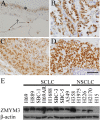ZMYM3 May Promote Cell Proliferation in Small Cell Lung Carcinoma
- PMID: 34764523
- PMCID: PMC8569135
- DOI: 10.1267/ahc.21-00012
ZMYM3 May Promote Cell Proliferation in Small Cell Lung Carcinoma
Abstract
Zinc finger, myeloproliferative, and mental retardation-type containing 3 (ZMYM3) is a highly conserved protein among vertebrates. Although it promotes DNA repair and moderate histone acetylation, the other functions of ZMYM3 remain unclear. We herein examined the physiological functions of ZMYM3 in human lung cancer using a ZMYM3-knockdown small cell lung cancer (SCLC) cell line. ZMYM3-knockdown SCLC cells grew slowly and the Ki-67 labeling index was lower in ZMYM3-knockdown cells than in mock cells. The subcutaneous tumors that formed after xenotransplantation into immunodeficient mice were slightly smaller in the ZMYM3-knockdown group than in the mock group. Furthermore, public RNA-sequencing data analyses showed similar RNA profiles between ZMYM3 and some cell proliferation markers. These results indicate that ZMYM3 promotes cell proliferation in human lung carcinomas, particularly SCLC.
Keywords: ZMYM3; cell proliferation; immunohistochemistry; lung carcinoma; mouse tissues.
2021 The Japan Society of Histochemistry and Cytochemistry.
Conflict of interest statement
VThe authors declare that there are no conflicts of interest.
Figures




Similar articles
-
ZMYM3 regulates BRCA1 localization at damaged chromatin to promote DNA repair.Genes Dev. 2017 Feb 1;31(3):260-274. doi: 10.1101/gad.292516.116. Epub 2017 Feb 27. Genes Dev. 2017. PMID: 28242625 Free PMC article.
-
Gene knockout of Zmym3 in mice arrests spermatogenesis at meiotic metaphase with defects in spindle assembly checkpoint.Cell Death Dis. 2017 Jun 29;8(6):e2910. doi: 10.1038/cddis.2017.228. Cell Death Dis. 2017. PMID: 28661483 Free PMC article.
-
Ascl1-induced Wnt11 regulates neuroendocrine differentiation, cell proliferation, and E-cadherin expression in small-cell lung cancer and Wnt11 regulates small-cell lung cancer biology.Lab Invest. 2019 Nov;99(11):1622-1635. doi: 10.1038/s41374-019-0277-y. Epub 2019 Jun 23. Lab Invest. 2019. PMID: 31231131
-
BMI1 reprogrammes histone acetylation and enhances c-fos pathway via directly binding to Zmym3 in malignant myeloid progression.J Cell Mol Med. 2014 Jun;18(6):1004-17. doi: 10.1111/jcmm.12246. Epub 2014 Feb 27. J Cell Mol Med. 2014. PMID: 24571310 Free PMC article.
-
Skewing of the genetic architecture at the ZMYM3 human-specific 5' UTR short tandem repeat in schizophrenia.Mol Genet Genomics. 2018 Jun;293(3):747-752. doi: 10.1007/s00438-018-1415-8. Epub 2018 Jan 13. Mol Genet Genomics. 2018. PMID: 29332164
References
-
- Alizadeh, F., Bozorgmehr, A., Tavakkoly-Bazzaz, J. and Ohadi, M. (2018) Skewing of the genetic architecture at the ZMYM3 human-specific 5' UTR short tandem repeat in schizophrenia. Mol. Genet. Genomics 293; 747–752. - PubMed
-
- Alizadeh, F., Moharrami, T., Mousavi, N., Yazarlou, F., Bozorgmehr, A., Shahsavand, E., et al. (2019) Disease-only alleles at the extreme ends of the human ZMYM3 exceptionally long 5' UTR short tandem repeat in bipolar disorder: a pilot study. J. Affect. Disord. 251; 86–90. - PubMed

